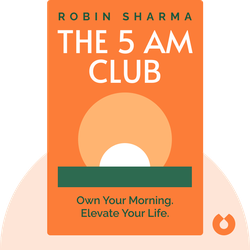Try Blinkist to get the key ideas from 7,000+ bestselling nonfiction titles and podcasts. Listen or read in just 15 minutes.
Start your free trial
Blink 3 of 8 - The 5 AM Club
by Robin Sharma

A History
'Drinking Water' by James Salzman outlines the history and current state of our drinking water systems, and offers strategies to protect it from pollution and privatization. It highlights the importance of water conservation and the impact of individual actions on the environment.
Though water may seem like a common element, it has a very interesting background.
For many centuries, and across numerous societies, water wasn’t a preferred drink. For example, the Roman upper-classes perceived water as a beverage suitable only for children, slaves or women who couldn’t drink wine.
Water continued to be perceived in the same way through to the Middle Ages and beyond, right up to and including the first pilgrims reaching the New World. Like upper-class Romans, the beer-loving pilgrims thought that water should be given only to the poorest members of the community. In the seventeenth century, there was even an English doctor who believed that drinking water could result in feeling melancholic.
Despite this, many believed in its supposed magical powers.
The idea of holy water and wells, springs or other sources holding enchanted water has been around for a long time. The Fountain of Youth, sought by the sixteenth-century Spanish explorer of the New World, Juan Ponce de León, is a famous example.
It’s likely that Ponce de León’s pursuit of rejuvenating water was embellished after his death, as nearly every other culture claims very similar stories.
According to Norse mythology, the god Odin searched for the transformative water that runs under Yggdrasil, a sacred tree that links all worlds.
Another similar tale comes from the Muslim world. In it, Alexander the Great’s political adviser Khidr makes it through the Land of Darkness to come upon a spring that could grant him immortality.
Heading into the fifteenth century, judge Sir John Fortescue said that the one reason to drink water was “for devotion.” In 1858, a miller’s daughter called Bernadette Soubirous apparently saw the Virgin Mary 18 times at a spring in Lourdes, France. Years after her death, Soubirous was declared a saint in 1933, and to this day, people travel from all over the world to try the water at Lourdes.



Drinking Water (2012) looks at our relationship with potable water. Weaving through history to the present day, the book reveals interesting and sometimes shocking facts about drinking water and our thirst-quenching habits.
Drinking Water (2021) by James Salzman explores the essential role that water plays in our lives and why it's crucial to protect this precious resource. Here's why this book is worth reading:
The notion that cleanliness is next to godliness took root during this era, and it made the religious community a powerful ally for sanitation reform.

It's highly addictive to get core insights on personally relevant topics without repetition or triviality. Added to that the apps ability to suggest kindred interests opens up a foundation of knowledge.
Great app. Good selection of book summaries you can read or listen to while commuting. Instead of scrolling through your social media news feed, this is a much better way to spend your spare time in my opinion.
Life changing. The concept of being able to grasp a book's main point in such a short time truly opens multiple opportunities to grow every area of your life at a faster rate.
Great app. Addicting. Perfect for wait times, morning coffee, evening before bed. Extremely well written, thorough, easy to use.
Try Blinkist to get the key ideas from 7,000+ bestselling nonfiction titles and podcasts. Listen or read in just 15 minutes.
Start your free trial
Blink 3 of 8 - The 5 AM Club
by Robin Sharma
What is the main message of Drinking Water?
The main message of Drinking Water is the importance of clean and accessible water for all.
How long does it take to read Drinking Water?
The reading time for Drinking Water varies depending on the reader's speed. However, the Blinkist summary can be read in just 15 minutes.
Is Drinking Water a good book? Is it worth reading?
Drinking Water is an eye-opening book that sheds light on the importance of water in our lives. It's definitely worth reading!
Who is the author of Drinking Water?
The author of Drinking Water is James Salzman.